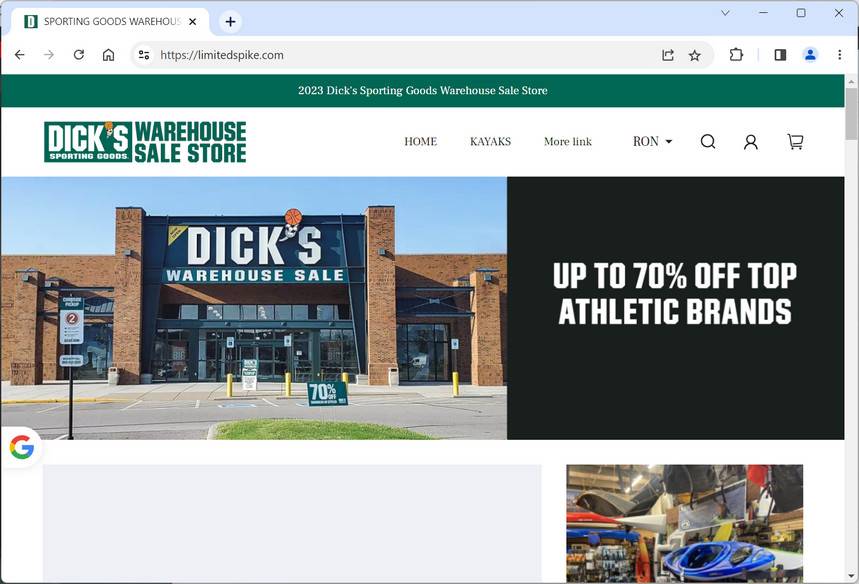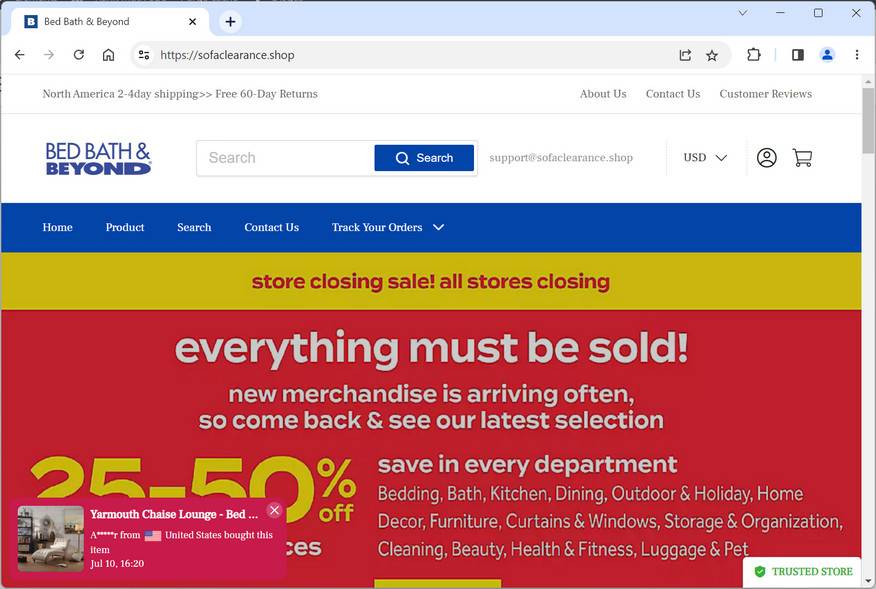Online shopping can be convenient and fun, but it also comes with some risks. One of them is falling prey to scam shopping sites that lure customers with low prices, fake reviews, and attractive products. In this blog post, we will expose one of the most common email addresses used by these scam shopping sites: Shop-vipservice01@outlook.com.
What are the Shop-vipservice01@outlook.com scam shopping sites?
Shop-vipservice01@outlook.com is an email address that appears on many websites that claim to sell various items, such as clothing, shoes, electronics, toys, and more. However, these websites are not legitimate online stores, but rather fraudulent schemes that aim to steal money and personal information from unsuspecting buyers.
These websites have several red flags that indicate they are not trustworthy, such as:
- Unrealistically low prices that are too good to be true.
- Poor grammar and spelling errors on the website content and product descriptions.
- Lack of information about the company, such as its address, phone number, or return policy.
- Fake or copied reviews from other websites or platforms.
- No secure payment methods or encryption on the checkout page.
- No customer service or response to inquiries or complaints.
How do the Shop-vipservice01@outlook.com scam shopping sites operate?
The Shop-vipservice01@outlook.com scam shopping sites operate by enticing customers with attractive products and discounts, and then asking them to pay with their credit card or other online payment methods. However, once the payment is made, the customer either receives nothing at all, or a low-quality or counterfeit product that does not match the description or image on the website.
In some cases, the customer may also receive an email from Shop-vipservice01@outlook.com asking for more personal information, such as their address, phone number, or bank account details. This is a phishing attempt that tries to obtain more sensitive data that can be used for identity theft or fraud.
The Shop-vipservice01@outlook.com scam shopping sites also use fake tracking numbers or shipping confirmation emails to make customers believe that their order is on its way. However, these tracking numbers are either invalid or belong to other unrelated shipments. The customer may also receive an email from Shop-vipservice01@outlook.com asking for more money to cover customs fees or taxes. This is another scam tactic that tries to extort more money from the customer.
How to Spot and Avoid Scam Online Shopping Websites
While scam sites appear convincing at first glance, several red flags can help identify their fraudulent nature:
Check for a Legitimate Domain Name and Company Details
- Fake sites often have domain names with odd spellings, extra words or use popular brand names. Search the company name online to confirm they are real.
- Check that a physical business address, working customer service phone/email are provided. Lack of real contact details indicates a shady seller.
Look for Overly Good-to-Be-True Deals
- Scam websites lure customers by advertising extravagant discounts of 50-90% off or deals well below market prices. Real businesses cannot sustain such heavy losses. If the deal looks too good to be true, it likely is.
Verify Company Reputation
- Search the website, business name and owner names online for any negative reviews or scam reports. Check with BBB, TrustPilot and complaint forums to see their reputation.
- No social media presence and zero signs of real customer activity on review sites signal likely frauds.
Analyze Site Security and Payment Options
- Ensure sites connect with SSL encryption and have guaranteed refund policies. Unsecured sites should not handle payments or sensitive data.
- Scam websites tend to only take irreversible payments like wire transfers, gift cards, cryptocurrency and avoid credit cards with stronger fraud protections.
Spot grammar errors, plagiarized policies, limited products
- Fake sites lack effort invested into proper grammar and original legal policy writing seen on established businesses.
- Very limited product selections avoiding common best-selling items categories also indicates pop-up scams.
Carefully applying these warning signs allows shoppers to expose scam retail fronts seeking solely to exploit rather than serve legitimate customer bases built on accountability and trust.
How to Spot This Scam on Social Media
In tandem with operating entirely fake e-commerce storefronts, retail scam websites heavily leverage sponsored social media ads promoting unbelievable yet highly compelling deals up to 90% off across product ranges in attempts to lure target audiences.
Highly deceptive posts explicitly screaming too-good-to-be-true price cuts frequently overrun Facebook feeds, Instagram stories and TikTok streams with aims of deceiving deal-seeking shoppers. However, certain patterns across these advertisements expose their underlying deceitful intentions.
Spotting Fraudulent Facebook Ads
Beware of too-good-to-be-true deals in Facebook ads like “90% off” or “Free Shipping” that entice people to shop. Scammers know how lucrative Facebook’s 2 billion users can be. Warning signs of a scam Facebook shopping ad:
- Extreme discounts such as “Store Closing Sale” or “Going out of Business” that seem suspicious for a newly created page. Legitimate businesses usually don’t heavily discount new inventory.
- Language and grammatical errors or inconsistencies throughout the ad or website. This signals the scammers likely quickly generated the content.
- Generic stock images of products rather than real images. Or images with watermarks that the scammer likely didn’t have rights to use.
- Very recent Page creation date shown under the Page name. Scam sites don’t last long before users report them or Facebook removes them.
If an ad or Page sets off warning bells, search for reviews of the website before purchasing. Or reverse image search any product photos to see if they were stolen from another site. Don’t support scammers taking advantage of Facebook users.
Spotting Fraudulent Instagram Ads
Scam online shopping sites try luring Instagram users with attention-grabbing captions like “Limited Time Offer!” and enticing prices such as “Today Only $39”. But is the Instagram shop legit or a scam? Signs to help determine:
- The account has very few posts and followers. Scams setup disposable accounts that get deleted once reported.
- Check user tags on the posts. If real people aren’t shown wearing or using the products, that’s a major red flag.
- Tap on the shop link in the bio. If there’s no HTTPS or SSL certificate, it’s not secure to enter payment information.
- Reviews seem fake or non-existent. Scam sites don’t have much satisfied customer proof.
- Limited or vague return policy information. Or difficult channels to request a return.
Trust your instinct if an Instagram shop seems fishy. Check independent review sites first before buying through an unknown seller advertising on Instagram. Protect your personal and payment information entering it only on secure sites after verifying legitimacy.
Catching Fake TikTok Ads
Scam TikTok shopping sites try attracting traffic using compelling videos showcasing unbelievable deals. But amazing discounts and prices may bait unsuspecting TikTok users into a scam. Be wary of:
- Links in the caption or videos bringing users to store sites no one’s heard of. Scammers setup temporary sites that won’t be around long.
- No blue checkmark verification badge on the account. This signals TikTok hasn’t authenticated the authenticity of the seller.
- Prices drastically slashed with countdown timers pressuring purchase decisions. Scare tactics rush rational judgement.
- No reviews or evidence showing real customers enjoying the products. Easy with video testimonials to fake satisfaction.
Check comment sections on TikTok scam shopping site videos for warnings from others getting duped. When prices seem too good to be true, they most likely are. Verify legitimacy before handing payment info to unknown sellers promoting on TikTok videos. Your security comes first.
What to do if you have fallen victim to the Scam Websites
If you have fallen victim to this scam, you should take immediate action to protect yourself and your money. Here are some steps that you can take:
- Contact your bank immediately – Alert your bank to disputed charges and consider canceling your card to prevent further fraudulent purchases.
- Keep records – Save receipts, emails, screenshots, and any details related to the transaction. This provides proof of the scam.
- File a complaint – Report the fraud to the FTC and Internet Crime Complaint Center. Provide any relevant records.
- Leave online reviews – Post details of the scam on consumer review sites to warn others. However, don’t defame legitimate businesses.
- Report social media accounts – If the scam involved social media, report the accounts to get them removed.
- Reverse payments – If you paid with a credit card, request a chargeback. For wire transfers, contact the recipient bank to possibly reverse it.
- Check credit reports – Request credit reports to check for any accounts opened fraudulently using your information. Consider placing a credit freeze if needed.
- Reset account passwords – Change passwords on any online accounts that used the same login credentials entered on the scam site.
- Check your device for viruses – Run a Malwarebytes Anti-Malware Free scan to check for any malware that may have infected your device through the site.
- Learn from the situation – Study how you were deceived so you can avoid other scams in the future.
Being vigilant against shopping scams and acting quickly when scammed can help limit financial and identity theft impact. Report it to help authorities investigate and shutdown scam sites that are still active.
Conclusion
Shop-vipservice01@outlook.com is an email address that is used by many scam shopping sites that try to deceive customers with fake products and low prices. These scam shopping sites are not reliable or safe, and they should be avoided at all costs. If you have encountered any of these scam shopping sites, you should report them and take measures to protect yourself from further harm.













